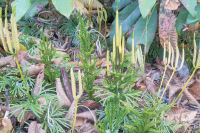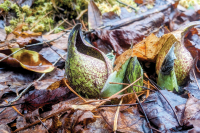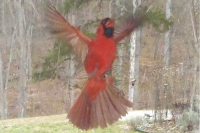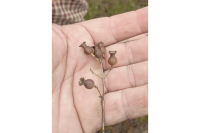Coexisting with bears
A group of wildlife lovers area has launched an initiative to make the Cashiers and Highlands area a “Bear Smart” community.
“Black bears can live with people. Can people live with black bears?” asked Bill Lea of Franklin, both a black bear expert and world-class nature photographer.
The “Bear Smart” project aims to educate homeowners on how to prevent bear conflicts, and how to handle them if they occur.
The Jackson-Macon Conservation Alliance is heading up the initiative, which also includes members Wild South and the Highlands Plateau Audubon Society chapter.
“Bears are a valuable and important part of the natural world,” said John Edwards, project coordinator for Wild South. “As stewards of our planet we are beholden to our creator to protect bears and their habitat as well as all creatures.”
To join the effort, contact Debbie at 828.526.0890, ext. 320 or via email at This email address is being protected from spambots. You need JavaScript enabled to view it..
Bear gets put down after close encounter with Smokies visitor
A visitor in the Great Smoky Mountains National Park got nipped on the foot by a bear after getting too close last week.
The visitor was on a high-traffic foot path at the entrance to the park right outside Gatlinburg, Tenn. In an effort to photograph the bear, the visitor allowed it to approach within inches. The bear bit the man’s foot and left a puncture wound so small that it did not require medical attention.
The bear will be euthanized, however. It’s park policy to euthanize a bear that injures a person for fear the bear may repeat the behavior. The bear had been hanging out around the trail that day, based on sightings by other visitors. Park rangers were unable to catch it that day, but went back again the next day and found it.
Given the bear’s willingness to approach humans, park rangers believe he had grown accustomed to being fed by park visitors, and even got reports from visitors who witnessed the bear being fed. Bears that develop a preference for human food can become more aggressive in their attempts to get it, which usually ends poorly for the bear.
It is illegal to approach wildlife, but in this case, the visitor technically was approached by the bear rather than approaching it.
“Our regulation is for individuals who willfully approach within 50 yards of a bear or elk,” said Nancy Gray, a spokesperson for the park. “That doesn’t apply if there is an encounter on the trail.”
Bears are usually hungry in the spring. They’ve depleted their winter fat stores, yet few foods are available yet. Bears are particularly hungry this year. They typically fatten up on acorns in the fall, but the acorn crop was scant last year. Many bears are underweight and in poor body condition, especially yearlings.
All visitors are advised to be even more diligent in keeping their distance and securing food.
An unfortunate object of affection
The Great Smoky Mountains National Park has long been synonymous with black bears. From the first automobile tourists to today’s long-distance backpackers, catching a glimpse of the the iconic animal is the ultimate Smokies’ experience.
Of course, it was much easier to see one in the park’s early days when tourists regularly fed the bears without fear of reprisal. While it’s illegal to feed wildlife now, it was once an accepted practice, ensuring tourists could get a good, long look.
There was no such thing as bear-proof trash cans, so campgrounds and picnic areas became the bears’ main stomping grounds, giving rise to a host of problematic encounters. Some bears even broke into vehicles to get food left inside.
“They were always trying to catch a bear that was mischevious and getting into trouble,” said Teresa Pennington, who spent lots of time in the park during her childhood years in Asheville. “They would have big traps set up with a piece of meat inside and the gate would fall behind them. They would take them out of the park and release them, but three or four weeks later they were back again. They even had names for them.”
Many of the tourist shops in Cherokee would put bears in a cage and charge tourists to see them, spawning a black market for live bears. Trying to catch a bear was not just a source of money but entertainment for the kids, recalled Gary Carden of Sylva.
“You would pull up at Smokemont and raise the trunk lid and throw a pound of bacon in the back and then go hide. When the bear came in there to get the bacon you slammed the lid and drove off. Sometimes the bear tore that car all to pieces. You would drive around half the night and if nobody wanted the bear you had to go back to the park and let it out,” Carden said
State forest users protests proposed bear hunt
A handful of lucky hunting parties were about to embark on a special bear hunt in DuPont State Forest last fall when wildlife managers realized they had gotten themselves in a bit of snare.
Reward offered in Parkway bear killing
A driver on the Blue Ridge Parkway last November witnessed a group of hunters and their dogs corner a black bear against a rock face and shoot it in stark violation of the no-hunting policy of national parks.
Peace in the valley: Franklin photographer Bill Lea captures beauty and history of Cades Cove in new book
For nature photographer Bill Lea, Cades Cove is heaven on earth.
Bear Care
By Jennifer Garlesky • Staff Writer
Kathy Sherrard and Anne Allison have dedicated their lives to educating the public about black bears.
What to do when you meet a bear
In his younger, more naïve hiking days, Joel Zachary found himself watching in slow motion as a bear charged toward him.
Bear frenzy over acorns attracts a crowd
Sometimes Bill Stiver, a wildlife biologist in the Great Smoky Mountains National Park, feels more like a social scientist than animal expert — especially when it comes to bears and tourists.
A harrowing tale of bear encounters
In the natural world there are certain experiences that rivet our attention and remain stored in our memory banks. Through the years I’ve written about my own encounters with rare plants, endangered landscapes, copperheads and timber rattlers, coyotes, skunks, eagles, red and gray foxes, box and snapping turtles, and so on. Not infrequently, I’ve received feedback from readers reporting that they have had similar experiences.









